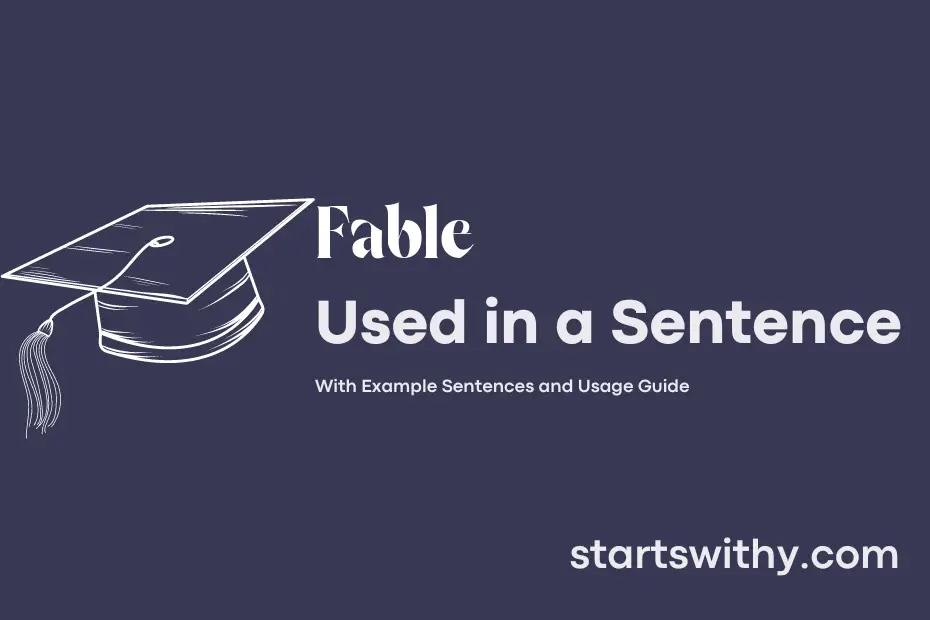Have you ever been captivated by a story that teaches a moral lesson through the adventures of talking animals or mythical creatures? That, my friend, is the essence of a fable.
A fable is a short narrative designed to convey a moral message in a simple and entertaining way, often featuring animals or inanimate objects as characters. Typically, these stories impart wisdom or a moral lesson that readers can apply to their own lives.
7 Examples Of Fable Used In a Sentence For Kids
- Fables are fun stories with a moral lesson.
- A fable usually has animals as characters.
- Fables can teach us about being kind.
- Reading fables before bed can be a good habit.
- The tortoise and the hare is a famous fable.
- Fables are like little lessons in a story.
- You can learn a lot from reading fables.
14 Sentences with Fable Examples
- Reading Aesop’s fables can be a fun way to unwind after a long day of classes.
- Analyzing the morals of various fables can help improve critical thinking skills.
- Discussing fables with classmates can lead to insightful conversations about human behavior.
- Writing a modern adaptation of a classic fable can be a creative assignment for an English literature course.
- Creating illustrations for a fable can be a relaxing break from studying for exams.
- Presenting a fable to a group of peers can help improve public speaking skills.
- Using fables to teach moral lessons in a children’s literature class can be a rewarding experience.
- Participating in a fable-writing competition can showcase one’s storytelling abilities.
- Debating the interpretations of fables in a philosophy class can stimulate intellectual curiosity.
- Applying the lessons learned from fables to real-life situations can foster personal growth.
- Utilizing fables to explore cultural values and traditions can deepen understanding of different societies.
- Adapting fables into short films can merge creativity with technological skills.
- Collaborating with classmates to enact a fable in a theatrical performance can enhance teamwork skills.
- Reflecting on the messages conveyed in fables can inspire introspection and self-improvement.
How To Use Fable in Sentences?
Fable is a noun that refers to a short story, often involving animals or mythical creatures, that conveys a moral lesson. To use fable in a sentence, simply include it in a context where you are describing a story with a moral message or lesson attached to it. For example, “The fable of the tortoise and the hare teaches us that slow and steady wins the race.”
When constructing a sentence with fable, make sure to provide enough context for the reader to understand that you are referring to a specific type of story. You can mention the moral lesson of the fable if it is relevant to your sentence. This helps to enhance the clarity and impact of your use of the word fable.
Additionally, you can use fable as a way to describe a story that may not be entirely true or that has a fantastical element to it. For instance, “The fable of King Arthur and the Knights of the Round Table is a classic tale of chivalry and honor.”
Overall, incorporating fable into your writing or speech can add depth and meaning to your message by drawing on the rich tradition of storytelling that has been passed down through generations.
Conclusion
In literature, fables are short stories that often contain moral lessons or allegorical meanings. Through their simple plots and characters, fables have been used for centuries to convey timeless wisdom and values in an engaging and accessible way. For example, “The Tortoise and the Hare” teaches the importance of perseverance and patience, while “The Boy Who Cried Wolf” illustrates the consequences of dishonesty.
Overall, fables continue to be celebrated for their ability to impart valuable life lessons through memorable and imaginative storytelling. By using animals or other characters to personify human traits and behaviors, fables serve as a timeless tool for teaching morals and ethics to readers of all ages.



